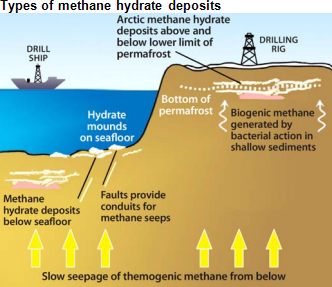
Potential of gas hydrates is great, but practical development is far off

Methane hydrates (or gas hydrates) are cage-like lattices of water molecules containing methane, the chief constituent of natural gas. They may represent one of the world's largest reservoirs of carbon-based fuel. However, with abundant availability of natural gas from conventional and shale resources, there is no economic incentive to develop gas hydrate resources, and no commercial-scale technologies to exploit them have been demonstrated.
Gas hydrates can be found under arctic permafrost, as well as beneath the ocean floor. They can also form during drilling and production operations. So far, gas hydrates have provided more problems than solutions. The formation of gas hydrates in deepwater production can hinder operations; managing or preventing their formation in deepwater oil and gas wells and pipelines has been a challenge for many decades, and addressing the existence of gas hydrates is a major part of planning for deepwater drilling and production. However, at some point in the future, gas hydrates could be a potential source of natural gas. When brought back to the earth's surface, one cubic foot of gas hydrate releases 164 cubic feet of natural gas.
According to the United States Geological Survey, the world's gas hydrates may contain more organic carbon than the world's coal, oil, and other forms of natural gas combined. Estimates of the naturally occurring gas hydrate resource vary from 10,000 trillion cubic feet to more than 100,000 trillion cubic feet of natural gas. Tapping such resources would require significant additional research and technological improvements. The U.S. Department of Energy recently selected 14 gas hydrate research projects to receive funding, building on a successful test in early 2012 in which a steady flow of natural gas was extracted from gas hydrates on Alaska's North Slope. Japan is also conducting research on producing gas hydrates from deepwater basins near its shores.
Tags: natural gas, production/supply, resources